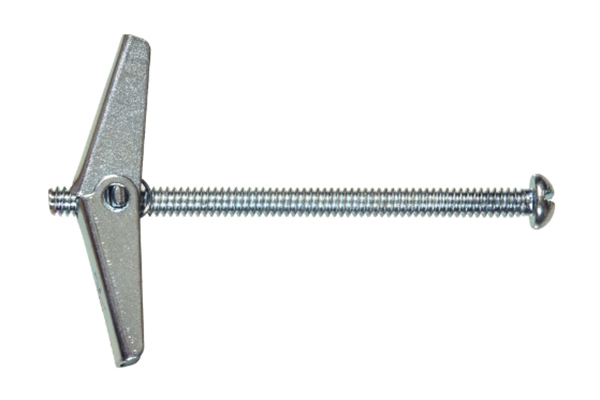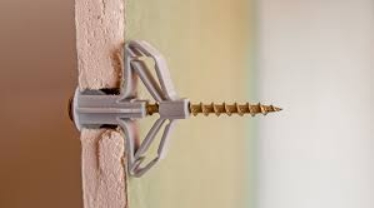Choosing between toggle bolts and drywall anchors becomes crucial when hanging heavy objects on drywall. Both options are commonly used for securing items to hollow walls but differ significantly in strength, application, and functionality. This article will explore the differences between toggle bolts and drywall anchors and provide a comparison to help determine which is stronger and better suited for specific applications.
What Are Toggle Bolts?
Toggle bolts, sometimes called toggle wing bolts, are fasteners designed for heavy-duty applications. They consist of a bolt with spring-loaded wings that expand once inserted through the drywall. These wings open behind the wall, providing a strong grip by distributing the load over a larger surface area.
Toggle bolts are ideal for mounting heavier objects, such as large shelves, cabinets, mirrors, or even televisions, to drywall. Their strength comes from the tension created by the wings as they press against the back of the drywall, effectively anchoring the bolt in place.
What Are Drywall Anchors?
Drywall anchors are lightweight fasteners designed for hanging lighter objects on drywall. There are several types of drywall anchors, including plastic expansion anchors, threaded anchors, and metal anchors, each offering varying degrees of holding power.
- Plastic expansion anchors work by expanding as the screw is driven into the anchor, securing it in the drywall.
- Threaded anchors are self-drilling and bite into the drywall as they are screwed in.
- Metal anchors, such as molly bolts, expand behind the drywall to hold the object in place.
Drywall anchors are suitable for lighter applications like hanging picture frames, towel racks, or small shelves. They are easier to install than toggle bolts but are not designed for supporting heavy loads.
Strength Comparison: Toggle Bolts vs. Drywall Anchors
Holding Capacity
The key difference between toggle bolts and drywall anchors is their holding capacity. Toggle bolts are much stronger than most drywall anchors due to the larger surface area over which they distribute the weight. Toggle bolts can typically hold weights ranging from 50 to 100 pounds or more, depending on the size of the bolt and the condition of the drywall. For instance, a 1/4-inch toggle bolt can hold up to 100 pounds in drywall, making it a reliable choice for heavier items.
On the other hand, standard drywall anchors, especially plastic ones, are generally rated for 15 to 50 pounds. Threaded and metal drywall anchors can hold more weight, with some metal anchors rated up to 75 pounds, but they still fall short of toggle bolts in terms of strength.
Wall Thickness
Another factor influencing strength is the thickness of the drywall. Toggle bolts perform well in thicker drywall, typically 5/8 inch or thicker. In thin drywall, however, the holding strength may be compromised because the wings of the toggle bolt cannot fully expand, limiting its effectiveness. Drywall anchors can also struggle with very thin drywall, but threaded anchors are usually more reliable in these cases since they bite directly into the drywall without relying on expansion behind the wall.
Installation Process
While toggle bolts are stronger, they are also more challenging to install. You need to drill a hole large enough to fit the wings of the toggle bolt, which is often significantly larger than the bolt itself. Additionally, once the wings are behind the wall, they cannot be removed unless the bolt is cut or pushed through the wall. This complexity means that toggle bolts may not be the best option for all applications, especially if the object being mounted is not permanent or will be moved frequently.
Drywall anchors, on the other hand, are much easier to install and remove. Most can be inserted directly into the wall with a screwdriver or drill, and plastic anchors can be easily pulled out without damaging the wall too much. For applications that involve lighter loads and frequent adjustments, drywall anchors may be more practical, despite their lower weight capacity.
Best Use Cases for Toggle Bolts
Toggle bolts are the preferred choice for:
- Mounting heavier items like cabinets, large mirrors, or televisions.
- Installing shelves that will bear substantial weight, such as kitchen shelving.
- Securing handrails or other fixtures that may be subjected to stress.
Because of their superior strength, toggle bolts are ideal for long-term, heavy-duty applications where safety and durability are critical.
Best Use Cases for Drywall Anchors
Drywall anchors are best suited for:
- Hanging light to medium-weight items such as picture frames, clocks, and small shelves.
- Securing curtain rods, towel racks, and other fixtures that do not require heavy-duty support.
- Applications where ease of installation and removal is a priority.
Conclusion: Which Is Stronger?
In terms of pure holding power, toggle bolts are stronger than drywall anchors. They are designed to support much heavier loads and are ideal for situations where stability and safety are paramount, particularly for items that will remain in place for extended periods. However, drywall anchors are often sufficient for lighter objects and offer easier installation and removal. The choice between the two depends on the specific requirements of your project, including the weight of the item being mounted, the condition of the drywall, and whether you prioritize strength or ease of use.
Ultimately, if strength is the primary concern and you are working with a heavy object, toggle bolts are the superior option. However, for more moderate applications, drywall anchors can provide an adequate and convenient solution.
Post time: Oct-23-2024

















